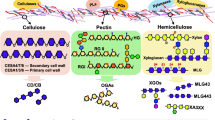Abstract
A study was conducted to determine whether the cuticles in two genera of the family Cruciferae are effective barriers to infection by Rhizoctonia solani, and whether differences in cuticle and epidermal cell wall thickness and morphology of epicuticular wax exist between resistant and susceptible cultivars. As Canola/rapeseed (Brassica napus) and mustard (Sinapis alba) plants develop from 1 to 3 weeks of age, they become increasingly resistant to R. solani AG2-1 seedling root rot. Seven-day-old seedlings of S. alba cultivars are invariably more resistant than B. napus cultivars. Brassica napus cultivars do not show an obvious cuticle layer at 1 week but at 3 weeks the presence of a cuticle is seen through autofluorescence with a concomitant increase in resistance to R. solani. Removal of the cuticle from 3-week-old hypocotyls by chloroform treatment results in a decrease in cuticular autofluorescence and a significant increase in disease severity in both resistant and susceptible cultivars. Three-week-old plants of S. alba have a much lower percent disease rating and a significantly (p=0.05) thicker cuticle layer than similar-age plants of B. napus. The results suggest that the cuticle plays an important role in the resistance of S. alba and older plants of B. napus to infection by R. solani.
Similar content being viewed by others
References
Armstrong D J and Whitecross M I 1976 Temperature effects on formation and fine structure of Brassica napus leaf waxes. Aust. J. Bot. 24, 309–318.
Baker E A 1982 Chemistry and morphology of plant epicuticular waxes. In The Plant Cuticles. Eds. D FCutler, K LAlvin and C EPrice. Academic Press, San Diego. 461 p.
Bateman D F 1964 An induced mechanism of tissue resistance to polygalacturonase in Rhizoctonia-infected hypocotyls of bean. Phytopathology 54, 438–445.
Bateman D F 1970 Pathogenesis and disease. In Rhizoctonia solani, Biology and Pathology. pp 161–171. Ed. J RParmeterJr. University of California Press, Berkeley. 255 p.
Bateman D F and Lumsden R D 1965 Relation of calcium content and nature of the pectic substances in bean hypocotyls of different ages to susceptibility to an isolate of Rhizoctonia solani. Phytopathology 55, 734–738.
Conn K L 1986 Leaf epicuticular wax of canola: Ultrastructure, chemistry and interaction with Alternaria brassicae. M. Sc. Thesis. Univ. of Alberta, Canada. 159 p.
Dodman R L and Flentje N T 1970 The mechanism and physiology of plant penetration by Rhizoctonia solani. In Rhizoctonia solani, Biology and Pathology. pp 161–171. Ed. J RParmeterJr. University of California Press, Berkeley. 255 p.
Flentje N T, Dodman R L and Kerr A 1963 The mechanism of host penetration by Thanatephorus cucumeris. Aust. J. Biol. Sci. 16, 784–799.
Gugel R K, Yitbarek S M, Verma P R, Morrall R A A and Sadasivahiah R S 1987 Etiology of the rhizoctonia root rot complex of canola in the Peace River region of Alberta. Can. J. Plant Pathol. 9, 119–128.
Holloway P J 1969 The effects of superficial wax on leaf wettability. Ann. Appl. Biol. 63, 145–153.
Holloway P J 1982. Structure and histochemistry of plant cuticular membranes: An overview. In the Plant Cuticle. Eds. D FCutler, K LAlvin and C EPrice. Academic Press, San Diego. 461 p.
Holloway P J and Baker E A 1970 The cuticles of some angiosperm leaves and fruits. Ann. Appl. Biol. 66, 145–154.
Kaminski D A and Verma P R 1985 Cultural characteristics, virulence and in vitro temperature effect on mycelial growth of Rhizoctonia isolates from rapeseed. Can. J. Plant Pathol. 7, 256–261.
Lees G L 1984 Cuticle and cell wall thickness: Relation to mechanical strength of whole leaves and isolated cells from some forage legumes. Crop Sci. 24, 1077–1081.
Marshall D S and Rush M C 1979 The relationship of cuticular waxes to the rice sheath blight disease. Texas Soc. Elec. Micros. Newslett. 10, 42 (abstr.).
Marshall D S and Rush M C 1980 Infection cushion formation on rice sheaths by Rhizoctonia solani. Phytopathology 70, 947–950.
Martin J T and Juniper B E 1970 The Cuticles of Plants. Edward Arnold, London. 347 p.
Massaquoi R C and Rush M C 1987 Relationship of quantity of epicuticular wax to resistance of rice to sheath blight. Phytopathology 77, 1723 (abstr.).
Reddy M N 1980 Studies on groundnut hypocotyl exdates and the behaviour of Rhizoctonia solani influencing the disease. Plant and Soil 55, 445–454.
Stockwell V and Hanchey P 1982 The effect of cuticle thinness on infection of older bean hypocotyls by Rhizoctonia solani. Phytopathology 72, 982 (abstr.).
Stockwell V and Hanchey P 1983 The role of the cuticle thickness in resistance of beans to Rhizoctonia solani. Phytopathology 73, 1640–1642.
Stockwell V and Hanchey P 1985 Effect of cuticle treatments on infection of Phaseolus vulgaris by Rhizoctonia solani. Phytopathol. Z. 114, 6–12.
Stringam G R 1971 Genetics of four hypocotyl mutants in B. campestris L. J. Hered. 62, 248–250.
Yang J 1989 Studies on Rhizoctonia solani diseases of rapeseed: germplasm screening, histo-cytopathology, cuticle thickness and calcium content in relation to resistance. M.Sc. Thesis, Univ. of Saskatchewan, Canada. 141 p.
Yang J, Verma P R, Rakow G F W and Downey R K 1989 Screening for resistance to Rhizoctonia solani AG2–1 in rapeseed and mustard. Can. J. Plant Pathol. 11, 200 (abstr.).
Author information
Authors and Affiliations
Rights and permissions
About this article
Cite this article
Yang, J., Verma, P.R. & Lees, G.L. The role of cuticle and epidermal cell wall in resistance of rapeseed and mustard to Rhizoctonia solani . Plant Soil 142, 315–321 (1992). https://doi.org/10.1007/BF00010977
Received:
Issue Date:
DOI: https://doi.org/10.1007/BF00010977




